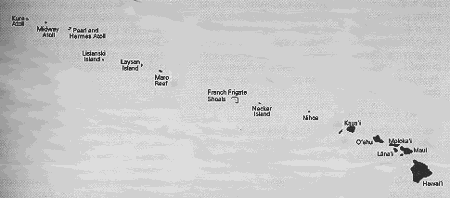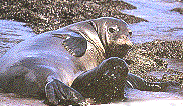Northwest Hawaiian Islands
Mai ka piʻina a ka la i Haʻehaʻe a i ka la welowelo i Lehua
From where the sun rises at Haʻehaʻe to its setting at Lehua
(Haʻehaʻe is at Kumukahi, Hawaii Island, Lehua is a small island north of Niʻihau)
The Hawaiian Archipelago includes the uninhabited islands that extend about 1000 miles northwest of Kauaʻi. They are a Federal Wildlife Refuge administered by the U.S. Fish and Wildlife Service.

Nihoa - Ancient name is Mokumana (bird island) is 150 miles NW of Kauaʻi along an ancient sea route. It is the tallest of the Northwest Islands at 903 feet, with 150 acres of Hawaiian burials, ancient agricultural terraces and extensive house sites. It was uninhabited at European contact.
Necker Island - Ancient name is Mokumanamana. The 45 acre, 300 ft tall island is narrow, rocky and shaped like a fish hook, with its shaft lying east-west and its hook pointing north from the west side. There are numerous heiaus and 33 Polynesian-design stone shrines of unknown origin that seem to indicate the island was once inhabited or at least used by ancient voyagers and fishermen. Archaeologists have found stone tools and other artifacts that are very much like those found in the main Hawaiian Islands. Radiocarbon dating suggests the island was first inhabited several hundred years after the main Hawaiian Islands were populated, and that visits to this island stopped some time before European contact.
French Frigate Shoals - Ancient name is Mokupapapa (low reef island) and is 560 miles NW of Honolulu. An atoll with a 22-mile-long reef complex and the 120 foot La Perouse Pinnacle may have been the island mentioned in voyage journals of Captain Cook. Hawaiians went to Mokupapapa to catch turtle by way of Kaula. The English searched the waters southwest of Kaula, the directions given them, but never found the island. Many believe Mokupapapa did exist near Kaula and disappeared many years ago, beneath the sea. The June, 2004, trip to the Northwest Hawaiian Islands, crew members of the voyaging canoe Hokuleʻa, reported seeing Hawaiian monk seals about 300 pounds and female breeding turtles about 3 feet, from neck to tail, and weighing about 225 pounds. The small coral sand islands of this atoll seem to be a favorite nesting place of the Hawaiian green turtle.

Hawaiian Monk Seal and Pup
Gardner Pinnacles - Ancient name is Puhahonu (turtle surfacing for air). The two rocky landfalls, the largest of which is only 300 yards long, are surrounded by 600,000 acres of coral reef habitat with at least 27 species of corals. The two islands appear to emerge unexpectedly like a turtle coming up for air.
Maro Reef - Ancient name is Nalukakala (surf that arrives in combers). This atoll is usually covered by breakers and has the second largest lagoon in the archipelago after French Frigate Shoals.
Laysan Island - Ancient name is Kauo (either the yolk or white of an egg). This flat island with a highly salted pond surrounded by sand and surf resembles a cracked egg and is home to thousands of birds. Inhabited from 1890 to 1915 by Max Schlemmer who managed a guano (bird droppings made into fertilizer) mining business and employed laborers from Japan. When the guano was exhausted, he tried to establish a coconut plantation and sold feathers to Japan for their millinery trade. Both ventures failed including a rabbit canning business that left the rabbits to proliferate and eat off nearly all the vegetation that changed Layson from a verdant wonderland of flowering plants and sandalwood trees into a sand-blown desert. Native land birds became extinct, including an orange honeycreeper closely related to the ʻapapane of the main Hawaiian island forests. The U.S. Fish and Wildlife Service is overseeing the restoration of the island
Lisianski Island -115 miles west of Laysan Ancient name is Papaʻapoho (flat island with a depression). The literal translation matches the physical description of this island.
Pearl and Hermes Atoll - Ancient name is Holoikauaua (the dog-like animal that swims in the rough), the name given to the endangered Hawaiian Monk Seal
Midway - Ancient name is Pihemanu (the loud din of birds) a bird sanctuary 58 miles east of
Kure Atoll - Ancient name is Kanemilohaʻi, the brother of Pele. He was left on this island as a guard when Pele came to Hawaii from Kahiki. Kure was named for a Russian navigator and gained the reputation of being the shipwreck isle. King Kalakaua had a wooden house built here in 1885, stocked with food, water and provisions to help anyone stranded on this oval shaped atoll. Loran (Long Range Aids To Navigation) Coast Guard Station was built here in 1960.